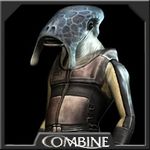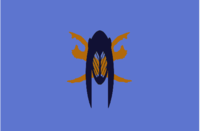Selkath
This article is a stub, meaning that it should be expanded. You can help the Holocron by adding to it.
 | |
| Selkath | |
| Homeworld | Manaan |
| Language | Selkatha [1] |
| Average Height | 1.5 meters [1] |
| Skin color | Blue or green [1] |
| Distinctions | Venom-tipped claws [1] |
| Average lifespan | Up to 100 standard years [1] |
| Known Members | List of known Selkath |
Contents
Biology and appearance
Selkath are the native species of the planet Manaan. An amphibious species, they are excellent swimmers and have the ability to hold their breath for very long periods of time when under water. Though they resemble anthropomorphic catfish and have aqua-coloured skin, they do not have gills. All members of the Selkath race have venom-tipped, retractable claws. Similar to the Wookiees, the use of these claws in any form of combat is considered dishonourable and a sign of madness.
Their mouths are bracketed by cephalic lobes. They tend to stroke these during conversation, analogous to the Human habit of stroking facial hair, such as mustaches. [1]
Society and culture
In ancient times, their ancestors were slaves to the Rakata, but gained their independence after the Infinite Empire's collapse. Since then, the Selkath have opted to remain neutral in times of intergalactic conflict. Their laws are very harsh, and it is not uncommon for violence or attempts to compromise Manaan's neutrality to be punished by death. The Selkath haven't forgotten their time as slaves under the Rakatans either; most Selkath seem to have an innate hatred toward slavery and the subjection of weaker species to those who have the power to force their own will upon them.
On Manaan, the Selkath have only one city above land, the planet's capital, Ahto City. This was done so that foreign dignitaries and interstellar visitors would feel comfortable, as the rest of the cities the Selkath inhabit are protected by the vast seas in which they exist.
In Selkath culture, a large female firaxan shark, known as the Progenitor, is seen as either a religious deity, or even an early evolutionary step in the Selkath chain. While some hold a reverence or even worship her as a mother goddess, others have embraced some of the other religious thoughts that are present throughout the galaxy. One of such faiths rose to prominence after the events of the Jedi Civil War, a Force tradition known as the Order of Shasa. While they have many members in Manaan, galaxy-wide their numbers are very small.
Pre-History
The Order of Shasa
The ancient Selkath of the Old Republic held an important place in the galaxy, producing a highly desired healing substance known as 'kolto'. During the events of the Jedi Civil War, the Sith manipulated several young Force-sensitive Selkath in an attempt to control this valuable resource. However, the plot was uncovered by a powerful Jedi, prompting the Ahto High Court to expel the Sith from the planet. The young Force-sensitive Selkath, recognizing their errors, pledged themselves to the well-being of all Selkath.
In the following years, the Order of Shasa was formed to secretly train Force-sensitive Selkath. Their priority was to protect the interests of Manaan and to maintain their neutrality, following a doctrine of moderation between both dark and light sides of the Force. Their experience of harmful foreign influences drove Shasa and her friends to avoid contact with external Force-using traditions. However, due to early exposure to the teachings of the Sith, the Order suffered from internal conflicts. Thereafter, they sought guidance from reputable Jedi and the Order prospered, producing many enlightened servants of the people.
When Manaan's source of kolto disappeared, it slipped into obscurity and became a minor player on the galactic stage. As a result, Selkath civilization reverted back to its clan origins. From its hidden base in the abandoned ruins of a kolto mining station, the Order continued to grow, unaided by external influences. Over time, it developed its own practices and conventions, with members serving as seers, military leaders, advisors, and story tellers.
One such practice is known as the Rite of Fira. The Fira sword is to Shasan Initiates and Adepts as the lightsaber is to the Jedi. To be considered an Initiate of the Order, members crafted their own sword by scavenging an ancient kolto harvester for the precious metal, cortosis. Cortosis gave the Fira sword the unique ability to resist high bursts of energy, as might come from lightsabers and blaster bolts. Using volcanic thermal vents on the ocean floor, the metal was shaped into the unique weapon.
[2][3][4]
References
[1] - http://starwars.wikia.com/wiki/Selkath [2] - http://starwars.wikia.com/wiki/Order_of_Shasa [3] - http://starwars.wikia.com/wiki/Selkath [4] - http://web.archive.org/web/20100212021720/http://wizards.com/default.asp?x=starwars/article/sw20040205manaan
